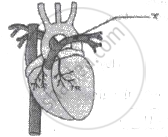Advertisements
Advertisements
Question
The diagram represents the ‘closed system’ or ‘double circulation’ of blood in mammals.
Justify the above statement.
State two structural and two functional differences between the arteries and veins.
State the changes in the composition of blood as it passes through the following organs:
(a) Lungs (b) Gut (c) Liver (d) Kidneys.
Solution
Double Circulation or closed system:
In human beings, the heart has double circulation as the blood passes through the heart twice.
(1) It first leaves the heart (right ventricle) and goes to the lungs and then returns to the heart (left auricle).
(2) From the left auricle, it circulates through the entire body and again returns to the heart (right auricle).
See Answer to Question 11, differentiate between.
(a) In the lungs, the blood releases carbon dioxide and picks up oxygen.
Hence before passing through the lungs, it contains more CO2 while it contains more oxygen after it has passed through the lungs.
(b) When blood passes through the gut, it absorbs digested food materials i.e., it contains more carbohydrates, proteins, fats, water, ions, and vitamins.
(c) As the blood passes through the liver, it contains more urea another waste materials.
(d) As the blood passes through kidneys, it contains less urea and other waste materials.
APPEARS IN
RELATED QUESTIONS
What is the significance of double circulation?
What is meant by the term 'Double circulation'?
What is the difference between pulmonary circulation and systemic circulation?
What does the term ‘double circulation’ mean?
Explain the Term
Double Circulation
In the given diagram, 'X' indicates ______

Name the vascular connection that exists between the digestive tract and liver.
Complete the following flow diagram of double circulation:

Why is the double circulation of blood in human beings necessary?
Name these:
Two phases of circulation of blood in human body
